SCI Students Bring A-Game to Summer Conferences
SCI Awarded COVID-19 Seed Grant
 Congratulations to Tolga Tasdizen whos Emerging COVID-19/SARS-CoV-2 Research Application has been awarded funding by the University of Utah Health’s 3i Initiative.
Congratulations to Tolga Tasdizen whos Emerging COVID-19/SARS-CoV-2 Research Application has been awarded funding by the University of Utah Health’s 3i Initiative. The project entitled AI/CXR Early Warning System for Infectious Respiratory Disease Outbreaks, proposes to research an early warning system for novel respiratory infectious disease outbreaks based on automated emerging cluster analysis of routine chest x-rays (CXR) using Artificial Intelligence/Machine Learning (AI/ML) and furthermore, to the use data collected during the COVID-19 pandemic to validate our proposed models.
ViSUS Utilized in Understanding COVID-19
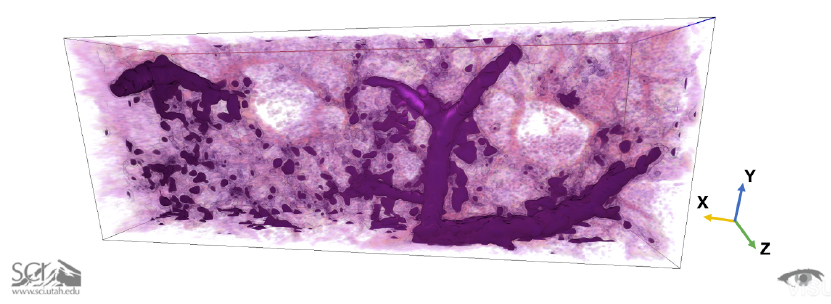
SCI Institute and CEDMAV alumnus, Brian Summa has been working with colleagues at Tulane University to study the effects of COVID-19 on lung tissue. This research is made possible using ViSUS to analyze high resolution histological volumes too large to visualize with other software.
Chris Johnson and Chuck Hansen Inducted into The IEEE Visualization Academy
 Chris Johnson and Chuck Hansen will be inducted into The IEEE Visualization Academy (or in short Vis Academy) during the opening session of the VIS 2019 conference in Vancouver, BC, on Tuesday, October 22, 2019. The Vis Academy was established in 2018 by the IEEE vgtc Executive Committee, with the inaugural “class” of inductees to include all the Visualization Career Awardees and all the Visualization Technical Achievement Awardees, from 2004 to 2019, for a total of 32 inductees. Induction into the Vis Academy is the highest and most prestigious honor in the field of visualization.
Chris Johnson and Chuck Hansen will be inducted into The IEEE Visualization Academy (or in short Vis Academy) during the opening session of the VIS 2019 conference in Vancouver, BC, on Tuesday, October 22, 2019. The Vis Academy was established in 2018 by the IEEE vgtc Executive Committee, with the inaugural “class” of inductees to include all the Visualization Career Awardees and all the Visualization Technical Achievement Awardees, from 2004 to 2019, for a total of 32 inductees. Induction into the Vis Academy is the highest and most prestigious honor in the field of visualization.
Every Breath You Take
Shortening Treatment for Lung Cancer Patients
 New research at the Scientific Computing and Imaging Institute at the University of Utah, helps to precisely target tumors in lung cancer patients using artificial intelligence. Employing algorithms developed by Sarang Joshi, DSc, professor of Biomedical Engineering and graduate student Markus Foote in collaboration with Amit Sawant, PhD, at the University of Maryland, Baltimore, and radiation oncologists will be able to predict movement in lung tumors as the patient breathes in real-time with a 3D motion model.
New research at the Scientific Computing and Imaging Institute at the University of Utah, helps to precisely target tumors in lung cancer patients using artificial intelligence. Employing algorithms developed by Sarang Joshi, DSc, professor of Biomedical Engineering and graduate student Markus Foote in collaboration with Amit Sawant, PhD, at the University of Maryland, Baltimore, and radiation oncologists will be able to predict movement in lung tumors as the patient breathes in real-time with a 3D motion model.
Announcing Intel Graphics and Visualization Institutes of XeLLENCE
- Scientific Computing and Imaging Institute (SCI) at University of Utah, supported by Dr. Chris Johnson.
- Texas Advanced Computing Center (TACC) at University of Texas, Austin with Kitware, Inc, supported by Dr. Paul Navratil and Dr. Berk Geveci.
- Visualization Institute of the University of Stuttgart (VISUS), supported by Dr. Ing. E. h. Thomas Ertl and Dr. rer. nat. Guido Reina.
HCI Announces Computational Oncology Research Initiative (CORI)
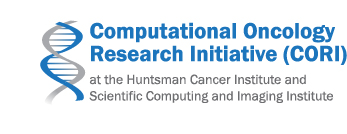 It is our distinct pleasure to announce that Howard Colman, MD, PhD, Professor in the Departments of Neurosurgery, Neurology, and Medicine (Oncology) has been appointed as the inaugural Director of the Computational Oncology Research Initiative (CORI), a new collaboration between Huntsman Cancer Institute and the Scientific Computing and Imaging (SCI) Institute.
It is our distinct pleasure to announce that Howard Colman, MD, PhD, Professor in the Departments of Neurosurgery, Neurology, and Medicine (Oncology) has been appointed as the inaugural Director of the Computational Oncology Research Initiative (CORI), a new collaboration between Huntsman Cancer Institute and the Scientific Computing and Imaging (SCI) Institute.
Sarang Joshi Elected as a Fellow of the American Institute for Medical and Biological Engineering (AIMBE)
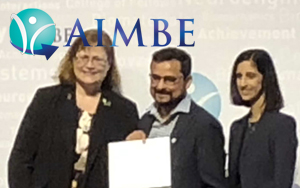 Congratulations to Sarang Joshi for being elected a Fellow of the American Institute for Medical and Biological Engineering (AIMBE).
Congratulations to Sarang Joshi for being elected a Fellow of the American Institute for Medical and Biological Engineering (AIMBE). Fellows are nominated each year by their peers and represent the top 2% of the medical and biological engineering community. They are considered the life-blood of AIMBE and work towards realizing AIMBE's vision to provide medical and biological engineering innovation for the benefit of humanity.
Charles Hansen appointed Distinguished Professor
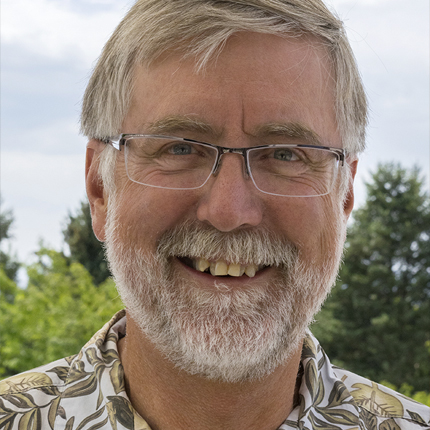 School of Computing professor Charles Hansen has been appointed as a Distinguished Professor of Computing at the University of Utah. The title of Distinguished Professor is a rare and prestigious honor granted by the University of Utah to faculty who meet the highest standards of scholarship, international stature, and dedication to teaching and service.
School of Computing professor Charles Hansen has been appointed as a Distinguished Professor of Computing at the University of Utah. The title of Distinguished Professor is a rare and prestigious honor granted by the University of Utah to faculty who meet the highest standards of scholarship, international stature, and dedication to teaching and service.
New Texas supercomputer to push the frontiers of science
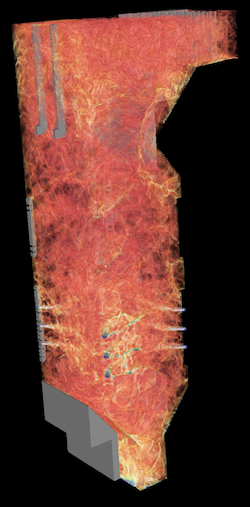 The National Science Foundation (NSF) announced today that it has awarded $60 million to the Texas Advanced Computing Center (TACC) at The University of Texas at Austin for the acquisition and deployment of a new supercomputer that will be the fastest at any U.S. university and among the most powerful in the world.
The National Science Foundation (NSF) announced today that it has awarded $60 million to the Texas Advanced Computing Center (TACC) at The University of Texas at Austin for the acquisition and deployment of a new supercomputer that will be the fastest at any U.S. university and among the most powerful in the world.The new system, known as Frontera (Spanish for "frontier"), will begin operations in 2019. It will allow the nation's academic researchers to make important discoveries in all fields of science, from astrophysics to zoology, and further establishes The University of Texas at Austin's leadership in advanced computing.
Read the full article at TACC
